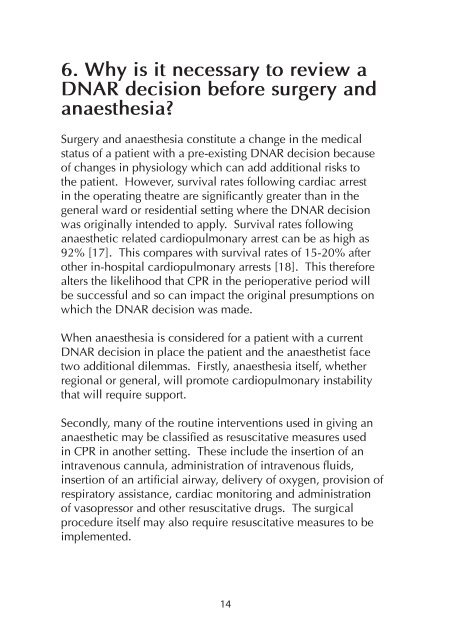Do Not Attempt Resuscitation (DNAR) Decisions in the ... - aagbi
Do Not Attempt Resuscitation (DNAR) Decisions in the ... - aagbi
Do Not Attempt Resuscitation (DNAR) Decisions in the ... - aagbi
You also want an ePaper? Increase the reach of your titles
YUMPU automatically turns print PDFs into web optimized ePapers that Google loves.
6. Why is it necessary to review a<br />
<strong>DNAR</strong> decision before surgery and<br />
anaes<strong>the</strong>sia?<br />
Surgery and anaes<strong>the</strong>sia constitute a change <strong>in</strong> <strong>the</strong> medical<br />
status of a patient with a pre-exist<strong>in</strong>g <strong>DNAR</strong> decision because<br />
of changes <strong>in</strong> physiology which can add additional risks to<br />
<strong>the</strong> patient. However, survival rates follow<strong>in</strong>g cardiac arrest<br />
<strong>in</strong> <strong>the</strong> operat<strong>in</strong>g <strong>the</strong>atre are significantly greater than <strong>in</strong> <strong>the</strong><br />
general ward or residential sett<strong>in</strong>g where <strong>the</strong> <strong>DNAR</strong> decision<br />
was orig<strong>in</strong>ally <strong>in</strong>tended to apply. Survival rates follow<strong>in</strong>g<br />
anaes<strong>the</strong>tic related cardiopulmonary arrest can be as high as<br />
92% [17]. This compares with survival rates of 15-20% after<br />
o<strong>the</strong>r <strong>in</strong>-hospital cardiopulmonary arrests [18]. This <strong>the</strong>refore<br />
alters <strong>the</strong> likelihood that CPR <strong>in</strong> <strong>the</strong> perioperative period will<br />
be successful and so can impact <strong>the</strong> orig<strong>in</strong>al presumptions on<br />
which <strong>the</strong> <strong>DNAR</strong> decision was made.<br />
When anaes<strong>the</strong>sia is considered for a patient with a current<br />
<strong>DNAR</strong> decision <strong>in</strong> place <strong>the</strong> patient and <strong>the</strong> anaes<strong>the</strong>tist face<br />
two additional dilemmas. Firstly, anaes<strong>the</strong>sia itself, whe<strong>the</strong>r<br />
regional or general, will promote cardiopulmonary <strong>in</strong>stability<br />
that will require support.<br />
Secondly, many of <strong>the</strong> rout<strong>in</strong>e <strong>in</strong>terventions used <strong>in</strong> giv<strong>in</strong>g an<br />
anaes<strong>the</strong>tic may be classified as resuscitative measures used<br />
<strong>in</strong> CPR <strong>in</strong> ano<strong>the</strong>r sett<strong>in</strong>g. These <strong>in</strong>clude <strong>the</strong> <strong>in</strong>sertion of an<br />
<strong>in</strong>travenous cannula, adm<strong>in</strong>istration of <strong>in</strong>travenous fluids,<br />
<strong>in</strong>sertion of an artificial airway, delivery of oxygen, provision of<br />
respiratory assistance, cardiac monitor<strong>in</strong>g and adm<strong>in</strong>istration<br />
of vasopressor and o<strong>the</strong>r resuscitative drugs. The surgical<br />
procedure itself may also require resuscitative measures to be<br />
implemented.<br />
14

















